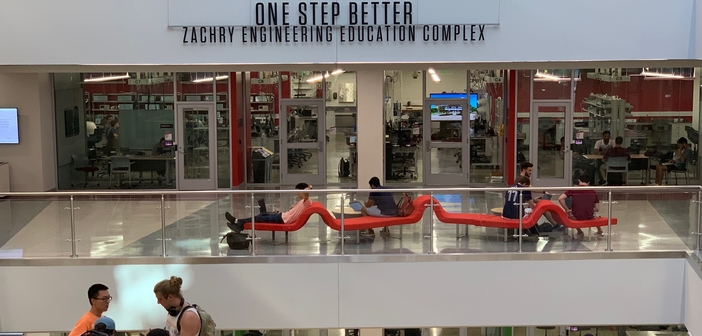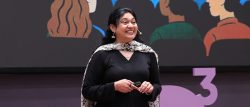“The engineer has been, and is, a maker of history.” ~ James Kip Finch
Habib University has put great value in the strong partnerships it has developed with renowned global institutions of higher education and strives to emulate lessons from their pedagogical experiences. Texas A&M University is one such institution that HU has built a successful relationship with and over a period, it has emerged as one of the institute’s strongest international partners.
The American university has played a valuable role in helping Habib become a hub for knowledge generation. This important partnership is solidified by the fact that Senior Associate Dean for Academic Affairs at Texas A&M, Dr. Mark Weichold, is also a member of HU’s Board of Governors.
HU and Texas A&M’s relationship was moved further forward during a recent trip made by Dr. Aamir Hasan —an Associate Professor and Program Director, Electrical and Computer Engineering (ECE) at the Dhanani School of Science & Engineering (DSSE) — to the Texas A&M campus.
Dr. Aamir visited Texas A&M from 11th to 13th September, 2019 to understand its innovative pedagogical experiments for undergraduate engineering education and to identify possible interventions that could be implemented at Habib University.
“Texas A&M has a big name in undergraduate engineering. What they have done is a great example not just for a liberal arts school, but for any undergraduate engineering school.”
With 18,000 undergraduate students and 22 different majors under the school of engineering, the scale of Texas A&M is immense. In 2010, the university conducted a study and discovered that around 50% of TAMU’s engineering students did not graduate in the major they had received admission. This discovery necessitated a transformation.
To address this issue, TAMU in 2013 wrote a strategic paper on how to change the undergraduate engineering education, including the formation of a uniform curriculum for the freshman year. This transformation included the development of its state-of-the-art Zachry Engineering Complex.
“Among the 18,000 engineering undergrad students, 5,000 students first year curriculum was made common.”

On the instrumental role the complex plays in the learning experiences, he adds, “The Complex was constructed while being kept in mind as to what an undergraduate engineering and especially a freshman’s educational and experiential experience should be like. Learning spaces, experiential spaces, project spaces, group discussions, all of these factors were kept in mind during the construction of the Zachry Engineering Education Complex.”

The Complex – spread over 525,000 square feet – houses three main instructional lab spaces including the Common Labs, SuSu & Mark A. Fischer ’72 Engineering Design Center and Shell Engineering Foundations Laboratory. By bringing together the labs, the collaborative spaces provides lab equipment for courses across the four year engineering curriculum with much more efficient usage as well as a number of capabilities that are now available to different majors instead of just one.

The common first-year engineering transformation was implemented in fall 2014 and since then has undergone few minor adaptations. Explaining the development, Dr Aamir said, “There are 22 different engineering majors including electrical, chemical, and petroleum engineering, with each student studying within their own orbit. TAMU took the freshman students and made a separate and common curriculum for them so that they would study the same thing.”

The undergraduate students were asked to complete their first year at engineering school but without a major. The students, all from different majors, were put together which led to increased collaboration. “Based on their [students]performance during the freshman year, they are allocated a major afterwards,” he said.
“They use a phrase ‘it’s all about the first year’ and this is very accurate.”
He noted that a major takeaway for Habib from the Texas A&M experience is that an engineering student’s first year is pivotal because it develops that student’s culture. “It’s how you transform that student. That transformation carries on for the sophomore, junior and senior years of the student.”
“When they started to execute this plan, the Complex was treated as a separate operational unit and with its effectiveness and efficiency the TAMU students learning experience was transformed dramatically,” he said.
An impressive statistic validates this transformation as initially the average TAMU engineering graduation rate was less than 50%. By taking this initiative in 2014 —with two batches having already graduated— the average graduation rate has now gone up to almost 90%.
Keen to learn how the dramatic changes in graduation rates had occurred, Dr. Aamir asked TAMU’s Electrical Engineering Program Director how this came about.
“By learning from experience and being allowed to find their own way in the first year, students made a thoughtful choice for their major in the second year,” said Dr. Aamir while recalling the program director’s explanation.
“We took a pointer from this. In our own DSSE, Computer Science, Electrical Engineering and Computer Engineering, three of our majors we have initiated a discussion on how to have a common first year curriculum. Initial work has begun and we are trying to move in that direction.”
Dr. Aamir said that Texas A&M faculty were very helpful and went out of their way to help him, which speaks volumes about their hospitality and professionalism. “I met around eight or nine faculty members over there, including those that take care of managing the freshman year. All of them went out of their way to help me. I give a great deal of credit for all of this to Dr. Mark Weichold,” he said.

For Dr. Aamir the entire trip was an enlightening experience, as he managed to see firsthand a prestigious institution reimagining the freshman experience. Summing up the learning, he optimistically said, “It was a very unique to see such a huge institution like Texas A&M doing a lot of research on engineering education and reimagining the freshman experience. We are examining our own learning environment at Habib University in light of the transformation done at TAMU. The lessons learned at TAMU, we at Habib would like to emulate wherever possible.”




